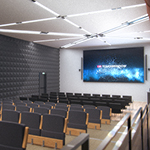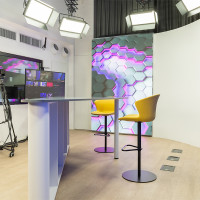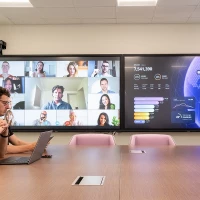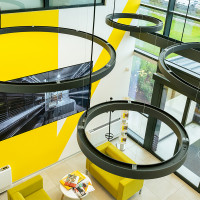
SHOWROOM
The perfect place to show what you've got
We create showrooms and corporate museums where you can tell your story in a new and exciting way.
Analysts estimate that the turnover of Multi-Touch interactive screens will reach 8 billion dollars in 2020. It is a clear sign of the success of these devices which are increasingly widespread in every type of environment, thanks to an interaction similar to that experienced daily by the vast majority of the population on smartphones and tablets.
Today it is common to find multi-touch screens in exhibition areas, for example in museums or art galleries, or in educational institutions, as an aid to teaching. But we can also find them in tourist offices, companies, design and planning offices, sales points, waiting areas, health facilities, and even in areas for collective catering, relaxation areas, large events, fairs and conferences.
In this wide range of digital devices, the interactive table occupies a special place, for a series of concrete advantages. We have identified 6 main ones.
The position in which it is most congenial for us to read, write and draw is definitely sitting. When we read a magazine, when we work on a text or an image, we are seated at a table. The interactive tables combine the convenience of the position, which allows a wide viewing angle, to the involvement of the touch interaction, which does not require instructions or training. Simple intuitive gestures are enough to interact with the contents, stimulating involvement and prolonging the stay.
In addition to offering an exciting experience, the interactive table is also a piece of furniture: its minimal design and customization options make it able to enhance any surroundings. Furthermore, being intended for intensive use, it is generally built with durable and safe materials: it therefore offers a stable and resistant support surface, which can be exploited in many ways. For example, in a professional studio we can keep projects, diagrams and tools on the table while continuing to work on the touch work area.
The interactive table you can offer a wide variety of experiences, according to your needs and strategies. Choose which type of content to make available: visual information, in the form of motion graphics, photographs, graphics, illustrations; textual information, with documents, titles, animations; entertainment, through gaming and audiovisuals; training, thanks to surveys, questionnaires, games. You can rely not only on the engagement offered by digital and the richness of multimedia, but also on the possibility of updating the contents, changing them, customizing them if they are no longer useful for your goals.
Unlike large screens, such as Video Walls, Touch walls or LED Walls, interactive tables can be easily moved and repositioned according to the needs. The hardware is integrated into the structure, so no complicated configurations are needed every time it is moved and reconnected to the power supply. Thanks to this, the interactive tables can be used successfully for itinerant events, fairs, temporary exhibitions, always guaranteeing maximum performance in a small and fast-moving space.
The rapid spread of interactive tables in restaurants is due to the enormous advantage they offer in terms of simplification and speeding up of the service. Instead of having to wait for the employee to complete the order, through the table you can choose and configure the desired meal with complete freedom. While waiting to be served, you can use the table for entertainment, perhaps leafing through digital magazines or playing games. Then, once the meal or snack is consumed, no queues at the cash desk, thanks to mobile payment. The result? More relaxed and satisfied customers, faster turnarounds, greater loyalty.
An interactive table gives users the opportunity to be completely autonomous in the use of content. For example, in a tourist office, visitors can find out itineraries for themselves, places, monuments, opening hours and everything they need to make the most of their holiday, without the need to have staff in charge. In addition, a dialog channel can be opened with them, for example allowing them to download the desired content to their device, eliminating the need to print brochures, flyers, or information leaflets. You can also sell advertising space for third-party companies, generating additional profits.
The interactive table is a device that enhances your space, furnishes and creates aggregation poles for your target thanks to digital engagement. It stimulates productivity, facilitating operations and processes. It improves the customer experience, engaging and entertaining users like never before.

We create showrooms and corporate museums where you can tell your story in a new and exciting way.

Solutions to attract visitors, entertain them and inform them through digital engagement.

Capture audience attention and engage viewers with impactful visualization systems and integrated AVL architectures.

A new technological setup to meet the communication needs of the Region.

The Emilia-Romagna Region expressed the need to create a Data Driven Decision Room to offer operational structures a new and innovative way to interact with the large amount of data available, make complex decisions with the help of 3D Data Visualization, and support administrative actions through easily comprehensible dashboards and images.

VALLI IS A FORLÌ-BASED COMPANY WITH OVER 50 YEARS OF HISTORY, REPRESENTING A NATIONAL AND INTERNATIONAL BENCHMARK IN THE DESIGN, PRODUCTION, AND INSTALLATION OF POULTRY EQUIPMENT. TOUCHWINDOW PARTICIPATED IN THE TECHNOLOGICAL SETUP OF THEIR NEW HEADQUARTERS IN VILLA SELVA, FORLÌ.